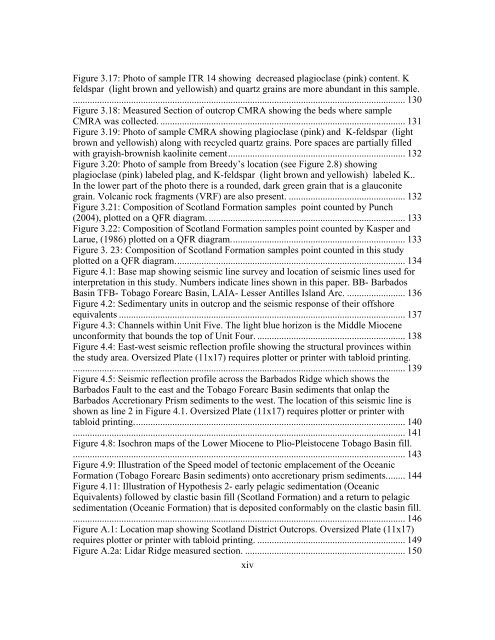Copyright by Nysha Chaderton 2009 - The University of Texas at ...
Copyright by Nysha Chaderton 2009 - The University of Texas at ...
Copyright by Nysha Chaderton 2009 - The University of Texas at ...
Create successful ePaper yourself
Turn your PDF publications into a flip-book with our unique Google optimized e-Paper software.
Figure 3.17: Photo <strong>of</strong> sample ITR 14 showing decreased plagioclase (pink) content. K<br />
feldspar (light brown and yellowish) and quartz grains are more abundant in this sample.<br />
......................................................................................................................................... 130<br />
Figure 3.18: Measured Section <strong>of</strong> outcrop CMRA showing the beds where sample<br />
CMRA was collected. ..................................................................................................... 131<br />
Figure 3.19: Photo <strong>of</strong> sample CMRA showing plagioclase (pink) and K-feldspar (light<br />
brown and yellowish) along with recycled quartz grains. Pore spaces are partially filled<br />
with grayish-brownish kaolinite cement......................................................................... 132<br />
Figure 3.20: Photo <strong>of</strong> sample from Breedy’s loc<strong>at</strong>ion (see Figure 2.8) showing<br />
plagioclase (pink) labeled plag, and K-feldspar (light brown and yellowish) labeled K..<br />
In the lower part <strong>of</strong> the photo there is a rounded, dark green grain th<strong>at</strong> is a glauconite<br />
grain. Volcanic rock fragments (VRF) are also present. ................................................ 132<br />
Figure 3.21: Composition <strong>of</strong> Scotland Form<strong>at</strong>ion samples point counted <strong>by</strong> Punch<br />
(2004), plotted on a QFR diagram. ................................................................................. 133<br />
Figure 3.22: Composition <strong>of</strong> Scotland Form<strong>at</strong>ion samples point counted <strong>by</strong> Kasper and<br />
Larue, (1986) plotted on a QFR diagram........................................................................ 133<br />
Figure 3. 23: Composition <strong>of</strong> Scotland Form<strong>at</strong>ion samples point counted in this study<br />
plotted on a QFR diagram............................................................................................... 134<br />
Figure 4.1: Base map showing seismic line survey and loc<strong>at</strong>ion <strong>of</strong> seismic lines used for<br />
interpret<strong>at</strong>ion in this study. Numbers indic<strong>at</strong>e lines shown in this paper. BB- Barbados<br />
Basin TFB- Tobago Forearc Basin, LAIA- Lesser Antilles Island Arc. ........................ 136<br />
Figure 4.2: Sedimentary units in outcrop and the seismic response <strong>of</strong> their <strong>of</strong>fshore<br />
equivalents ...................................................................................................................... 137<br />
Figure 4.3: Channels within Unit Five. <strong>The</strong> light blue horizon is the Middle Miocene<br />
unconformity th<strong>at</strong> bounds the top <strong>of</strong> Unit Four. ............................................................. 138<br />
Figure 4.4: East-west seismic reflection pr<strong>of</strong>ile showing the structural provinces within<br />
the study area. Oversized Pl<strong>at</strong>e (11x17) requires plotter or printer with tabloid printing.<br />
......................................................................................................................................... 139<br />
Figure 4.5: Seismic reflection pr<strong>of</strong>ile across the Barbados Ridge which shows the<br />
Barbados Fault to the east and the Tobago Forearc Basin sediments th<strong>at</strong> onlap the<br />
Barbados Accretionary Prism sediments to the west. <strong>The</strong> loc<strong>at</strong>ion <strong>of</strong> this seismic line is<br />
shown as line 2 in Figure 4.1. Oversized Pl<strong>at</strong>e (11x17) requires plotter or printer with<br />
tabloid printing................................................................................................................ 140<br />
......................................................................................................................................... 141<br />
Figure 4.8: Isochron maps <strong>of</strong> the Lower Miocene to Plio-Pleistocene Tobago Basin fill.<br />
......................................................................................................................................... 143<br />
Figure 4.9: Illustr<strong>at</strong>ion <strong>of</strong> the Speed model <strong>of</strong> tectonic emplacement <strong>of</strong> the Oceanic<br />
Form<strong>at</strong>ion (Tobago Forearc Basin sediments) onto accretionary prism sediments........ 144<br />
Figure 4.11: Illustr<strong>at</strong>ion <strong>of</strong> Hypothesis 2- early pelagic sediment<strong>at</strong>ion (Oceanic<br />
Equivalents) followed <strong>by</strong> clastic basin fill (Scotland Form<strong>at</strong>ion) and a return to pelagic<br />
sediment<strong>at</strong>ion (Oceanic Form<strong>at</strong>ion) th<strong>at</strong> is deposited conformably on the clastic basin fill.<br />
......................................................................................................................................... 146<br />
Figure A.1: Loc<strong>at</strong>ion map showing Scotland District Outcrops. Oversized Pl<strong>at</strong>e (11x17)<br />
requires plotter or printer with tabloid printing. ............................................................. 149<br />
Figure A.2a: Lidar Ridge measured section. .................................................................. 150<br />
xiv
















